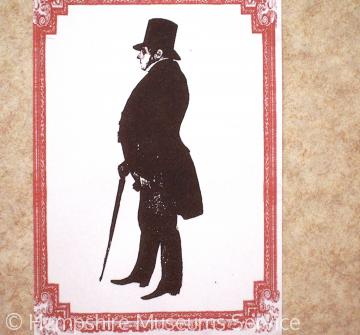Robert Cottle, postmaster, stationer, book binder and printer, Winchester Street, Basingstoke, 1788-1859

Robert Cottle was born in Taunton in 1788, a son of Moses Cottle. His brother Moses was born in Taunton two years later.[1] They both came to Basingstoke
On Easter Monday, 28 April 1821 Robert organised a trip in his boat along the Basingstoke Canal to the Little Tunnel. The party of 13 included Samuel Attwood who recorded the event in his diary, as well as Cottle’s marriage at Alresford in 1826 to Miss Maria Houghton. [2]
Robert Cottle appears in directories from 1828 to 1859 as postmaster, stationer, book binder and printer. The 1841 census shows him in Winchester Street, as a printer employing two men. His household included his wife, his brother Moses (a stationer) his mother-in-law, an assistant, an apprentice, a 14-year-old boy and 2 servants.
The fine print of the Town Hall just before its replacement was printed by Robert Cottle, as were many of the billheads (between 1814 and 1857) that are now held by the Hampshire County Museum & Archives Service.[3]
Cottle’s own billheads show his premises in Winchester Street (until recently The Litten Tree) and a printing machine which presumably is the one he used. Details on his billheads vary over the years, advertising him as printer, bookseller, stationer, music and print seller and binder and running a circulating library and a toy warehouse. His shop sold ‘genuine and approved patent medicines’, gold and fancy papers etc, perfumes, combs, hair, nail and clothes brushes, cutlery, account books, children’s books, Common Prayer Books and Bibles. Schools were ‘supplied on the most liberal terms’ and he offered ‘orders for new publications’. His customers included Lord Bolton, Lady Dorchester, many prominent townsmen and clergymen as well as The Portrait Committee, the Firework Committee and The Committee for conducting the Celebration of Peace (1858). His postbox is in the Willis Museum.
He was Hon. Secretary to the Art Union of London. More locally, he was a prominent member of the Mechanics’ Institute, while Mr Tabb, a compositor employed by him, gave a talk to the Mutual Improvement Society on ‘the Natural History of Creation’.[4] Tickets for the 1851 Annual Winter Ball were ‘to be had from Mr Cottle, bookseller, Basingstoke.’ [5]
A prominent man in town affairs, he was listed as a Commissioner for the Paving Act in 1815[6] and elected to the Council in 1835.[7] In 1836 he was on a committee to look into the best plan for enlarging the Lesser Market. In 1851 he became a Market Commissioner at a time when the farmers were protesting strongly against the Council’s decision to re-impose Market Tolls which had been lifted temporarily after the building of the new Town Hall and re-organising the Market in 1834.[8] He was Mayor five times: 1838-9, 1845-46, 1846-47, 1849-50, and 1853-54.
He died in 1859, aged 71.[9] Presumably he was buried with his brother Moses and other members of his family whose tombstone can be found in Basingstoke’s Holy Trinity Chapel, but although three sides of the tombstone bear oval plaques recording them; the fourth side is missing what one assumes would have been Robert Cottle’s plaque.
[1] A History of the Town and Manor of Basingstoke F J Baigent & J E Millard, Basingstoke 1889 p 484
[2] Diary of Samuel Attwood, Hampshire Record Office 8M62/27
[3] HCMAS WOC 5226
[4] Reading Mercury 15 March 1851
[5] Reading Mercury 4 January 1851
[6] HRO 23M72/B02
[7] A History of the Town and Manor of Basingstoke F J Baigent & J E Millard, Basingstoke 1889 pp 482,483, 484
[8] Reading Mercury 10 May 1851
[9] Baigent & Millard p 484
Content derived during research for the new VCH Hampshire volume, Basingstoke and its surroundings.





